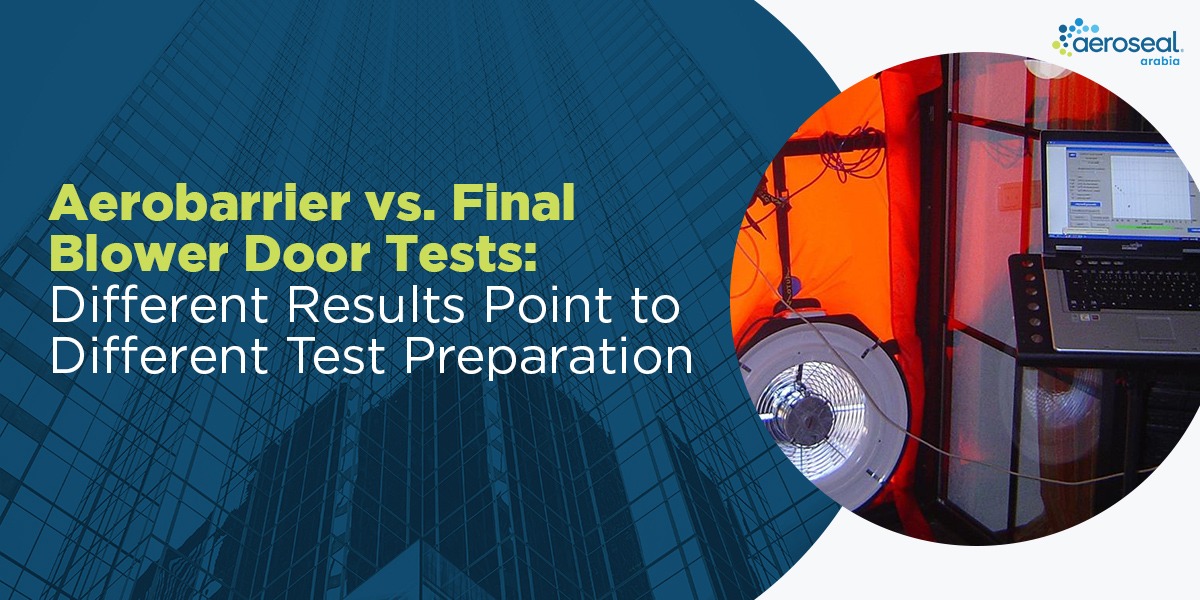
Aerobarrier vs. Final Blower Door Tests: Different Results Point to Different Test Preparation
when it comes to testing a building’s airtightness, the blower door test is the standard method used across the construction industry. It measures how much air leaks in and out of a structure, helping builders and engineers understand how energy efficient a building truly is.
AeroBarrier also relies on the blower door test but uses it differently. During the sealing process, the system monitors air leakage in real time and automatically seals gaps in the building envelope until the desired airtightness is reached. However, when a final blower door test is performed afterward, results sometimes differ. Let’s explore why this happens and why preparation makes all the difference.
Understanding How AeroBarrier Works
The AeroBarrier system uses controlled air pressure to distribute a safe, water-based sealant into the building. This sealant finds and closes even the smallest leaks, sometimes as tiny as a human hair. During the process, AeroBarrier’s software continuously monitors the air changes per hour (ACH) a measure of how often indoor air is replaced by outdoor air due to leakage.
By sealing leaks in real time, AeroBarrier achieves precise levels of airtightness that meet or exceed energy and building code requirements. Once the process is complete, the results are recorded to show how much leakage was reduced.
Why the Final Blower Door Test Shows Different Results
After the AeroBarrier process, when the final blower door test is conducted, some builders notice slightly higher leakage rates. This difference can cause confusion, but the reason lies in test preparation.
During the AeroBarrier Process
Certain areas are intentionally covered or sealed to protect them from the sealant, including:
- Windows and doors
- Fireplaces
- Range hoods and exhaust vents
- Supply and return ducts
This controlled setup ensures the sealant only targets leaks where it’s needed and avoids coating unwanted surfaces.
During a Standard Blower Door Test
For the final blower door test, these same areas are uncovered and left in their normal condition, such as:
- Windows and doors (operable and unsealed)
- Fireplaces
- Range hoods
- HVAC equipment and dampers
Because more openings are exposed during the test, air can move more freely, resulting in a higher recorded leakage.
The Importance of Consistent Preparation
The key factor in comparing results is consistent test preparation. Since the AeroBarrier test involves temporary coverings and the blower door test does not, the difference in leakage values is completely normal.
AeroBarrier-certified technicians account for this by adjusting the sealing process to make the building slightly tighter during application. This compensates for the air movement that will return once temporary coverings are removed. As a result, builders can still meet and often exceed their airtightness goals after the final test.
Guaranteed Results with AeroBarrier
AeroBarrier provides predictable and guaranteed results. Because the system can dial in a specific level of airtightness during application, builders no longer need to rely on guesswork or multiple retests.
Over time, teams learn the typical variance between the two test methods and plan accordingly. This helps them confidently meet energy efficiency standards, pass inspections, and comply with building codes especially those that emphasize airtightness and reduced energy waste.
Why This Matters for Saudi Arabia’s Vision 2030
In Saudi Arabia, the construction industry is shifting toward sustainable and high-performance buildings in line with Vision 2030. Managing airtightness is a critical part of that transformation, reducing energy demand while improving comfort and indoor air quality.
Using AeroBarrier during construction or renovation helps developers and contractors achieve airtightness targets faster, avoid costly rework, and ensure compliance with energy efficiency standards all while contributing to a greener, smarter future for Saudi Arabia.
Conclusion
The difference between AeroBarrier and final blower door test results comes down to one thing: preparation. The AeroBarrier process is designed to seal leaks efficiently under controlled conditions, while the final blower door test measures the building’s real-world performance once all openings are restored.
Both tests are essential for verifying a building’s airtightness and ensuring long-term energy efficiency. By understanding how they differ, builders can interpret their results accurately and ensure every project meets the highest standards of quality and performance.



